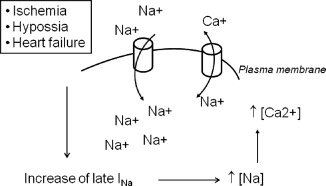Figure 1.

Pathophysiology of sodium‐induced calcium overload. In those situations in which late INa increases (ischemia, heart failure, hypoxia), the intracellular concentration of sodium increases, which in turn runs the Na+/Ca++ exchanger in reverse mode (ie, by sodium exit and calcium enter in the cardiac cell). The result is an overload of calcium that contributes to the appearance of electrical, mechanical, and metabolic alterations that are associated with cardiac ischemia. In the figure, cylinders represent the Na+/Ca++ exchanger in reverse mode.
